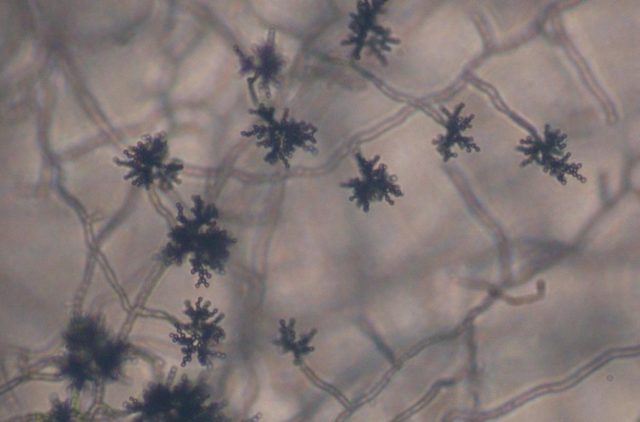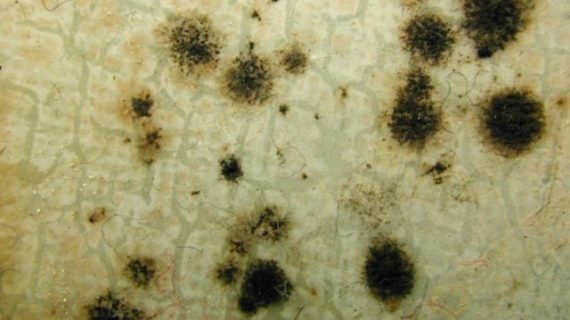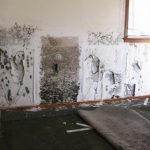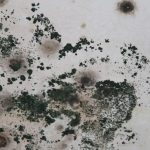Cladosporium mold is a common fungi species you can find both indoor and outdoor. Its ubiquitous presence is generally harmless, but unfortunately, there are still several side effects that can happen when people are in contact with the spores.
Learn what you need to know about this mold species, and how you can avoid the health risks caused by Cladosporium mold.
What is Cladosporium Mold?
Cladosporium is not a specific name for a single species. It is a genus that consists of various indoor and outdoor mold species.
Outdoor, Cladosporium may grow as fungi on dead plants, decaying wood, or tree trunks. Some of the species are parasitic, while others are actually pathogen, which causes diseases on agricultural plants.
Indoor, Cladosporium mold often grows on objects such as carpets, curtains, upholstery, and wallpaper. It can also appear on window sills and plywood.
Cladosporium mold also loves places that are dark and moist all the time, such as under the sink, bathroom corners, around the faucets, and in the basement.
Cladosporium mold appears as green, black, or yellowish dots, which spread in large clusters when left without being cleaned. There is no way to identify the species of the mold with just eyes, so you need lab testing to determine the type of the mold.
Nevertheless, the presence of large mold in the house is still problematic, especially if there are people with compromised health conditions or immune systems.
Is Cladosporium Mold Dangerous?
Most species of Cladosporium are not a pathogen, but the spores can still be dangerous for humans. Long exposure can cause various health conditions, such as:
- Eye infections
Eyes are a sensitive organ, and when exposed to mold spores for a long time, it can develop infection signs such as red and watery eyes, itchiness, and dryness.
- Ear infections
There are cases where long exposure of Cladosporium spores caused signs of ear infections, especially when spores are stuck inside the ear canals, and cannot be cleaned properly because they are stuck to ear wax.
The signs include itchiness, painful sensation, and even liquid discharge.
- Skin problems
Another rare case of Cladosporium spore exposure is a skin problem. There are various signs that a person may mistake with other skin conditions, such as rashes, redness, and itchiness.
- Sinus infection
Sinus is a part that can get affected much by long mold exposure. The signs may include painful sensation in the sinus, headache that roots from the sinus, blocked nose, and even sore throat.
- Allergic reactions
A person with allergies can get their symptoms triggered by Cladosporium mold spores. They may experience asthma-like symptoms, sneezing, coughing, red eyes, and other common allergy signs.
There are several types of people that are prone to the worst effects of mold spore exposure.
Babies, toddlers, children, people with pulmonary diseases, asthma and allergies, people with compromised immune system, and the elderly are especially prone to negative effects from mold.
Cladosporium Mold Exposure Symptoms
The early signs of Cladosporium mold exposure symptoms can be indistinguishable from regular ailments, such as cold or flu.
Many people fail to detect the possibility of mold exposure because of this, which increases the health risks even more. The most common symptoms of mold exposure may include:
- Headache and dizziness.
- Inexplicable fatigue or exhaustion.
- Wheezing breaths and /or difficulty of breathing.
- Nasal discharge and blocked nose.
- Sore throat.
- Chest pain.
- Sneezing and coughing.
- Red, watery, itchy eyes.
Pay attention if you suddenly experience some of these symptoms without explanations, especially if you are actually in top health condition.
If you have preexisting condition such as asthma or allergy, be aware if your symptoms are triggered more easily in a certain building.
They can signal possibilities of mold exposure, especially if the building is old or known to have leak/plumbing problem.
Cladosporium Mold Removal Strategies

The easiest way to prevent the spread of Cladosporium mold in your house is doing prevention against moisture. Make sure you keep all the plumbing joints in good condition.
Fix all leak problems as soon as possible. Do not install carpet in areas that easily get wet. If there are spots with high leak risk, install leak detector. Using wall paint with anti-mold formula can also be a practical solution.
However, when the mold already appears in your house, you must remove it as soon as possible. A large infestation that spreads to more than 10 square feet area requires professional remediation.
Meanwhile, if the mold problem is still small, you can try these methods to remove it:
-
Vinegar solution
The acidic nature of vinegar can work wonder in removing a small amount of mold. Mix one part of white vinegar with three parts of water, and put the mixture in spray bottle. Spray the moldy surface, and scrub it until the mold disappears. Let the moisture dries up naturally, and repeat the process.
-
Detergent and bleach
You can use detergent and bleach mixture if the mold problem is a little thick (but still manageable). Mix mild detergent in water as much as you need, and add a little bleach. Scrub hard until the mold disappears.
-
Hydrogen peroxide
Hydrogen peroxide can also help removing light mold problems. Add one part of the peroxide with three parts of water, and put the mixture in spray bottle. Spray it on the mold and scrub hard. Let it dry before repeating the process.
During the cleaning process, you must wear goggles, mask, and gloves. Do not forget to open the window and let fresh air enter when cleaning.
If there are materials such as fabric, plastic curtain, or upholstery that are moldy, it is better to throw them out. Put them in double bags and tie them tightly. Afterward, install exhaust fan and dehumidifier in the house if you do not have them.
Large-scale mold problem always brings health risks, especially for people with vulnerable health conditions.
Cleaning the mold or calling professional are the common solutions, but the best way to avoid mold exposure is keeping the house clean, ventilated, and well-lit.
Cladosporium mold may carry health risks, but you can avoid them with proper removal and prevention strategies.






